Brain-specific homeobox factor as a target selector for glucocorticoid receptor in energy balance
- PMID: 23671185
- PMCID: PMC3700135
- DOI: 10.1128/MCB.00094-13
Brain-specific homeobox factor as a target selector for glucocorticoid receptor in energy balance
Abstract
The molecular basis underlying the physiologically well-defined orexigenic function of glucocorticoid (Gc) is unclear. Brain-specific homeobox factor (Bsx) is a positive regulator of the orexigenic neuropeptide, agouti-related peptide (AgRP), in AgRP neurons of the hypothalamic arcuate nucleus. Here, we show that in response to fasting-elevated Gc levels, Gc receptor (GR) and Bsx synergize to direct activation of AgRP transcription. This synergy is dictated by unique sequence features in a novel Gc response element in AgRP (AgRP-GRE). In contrast to AgRP-GRE, Bsx suppresses transactivation directed by many conventional GREs, functioning as a gene context-dependent modulator of GR actions or a target selector for GR. Consistent with this finding, AgRP-GRE drives fasting-dependent activation of a target gene specifically in GR(+) Bsx(+) AgRP neurons. These results define AgRP as a common orexigenic target gene of GR and Bsx and provide an opportunity to identify their additional common targets, facilitating our understanding of the molecular basis underlying the orexigenic activity of Gc and Bsx.
Figures
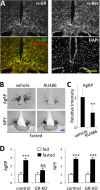
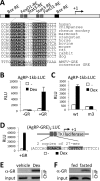
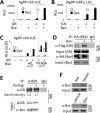

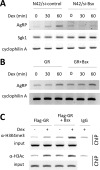

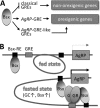
Similar articles
-
Glucocorticoids increase neuropeptide Y and agouti-related peptide gene expression via adenosine monophosphate-activated protein kinase signaling in the arcuate nucleus of rats.Endocrinology. 2008 Sep;149(9):4544-53. doi: 10.1210/en.2008-0229. Epub 2008 Jun 5. Endocrinology. 2008. PMID: 18535107
-
Control of energy balance by hypothalamic gene circuitry involving two nuclear receptors, neuron-derived orphan receptor 1 and glucocorticoid receptor.Mol Cell Biol. 2013 Oct;33(19):3826-34. doi: 10.1128/MCB.00385-13. Epub 2013 Jul 29. Mol Cell Biol. 2013. PMID: 23897430 Free PMC article.
-
AgRP Neuron-Specific Deletion of Glucocorticoid Receptor Leads to Increased Energy Expenditure and Decreased Body Weight in Female Mice on a High-Fat Diet.Endocrinology. 2016 Apr;157(4):1457-66. doi: 10.1210/en.2015-1430. Epub 2016 Feb 18. Endocrinology. 2016. PMID: 26889940
-
Role of homeobox genes in the hypothalamic development and energy balance.Front Biosci (Landmark Ed). 2013 Jan 1;18(2):740-7. doi: 10.2741/4136. Front Biosci (Landmark Ed). 2013. PMID: 23276958 Review.
-
Central orchestration of peripheral nutrient partitioning and substrate utilization: implications for the metabolic syndrome.Diabetes Metab. 2014 Jun;40(3):191-7. doi: 10.1016/j.diabet.2013.11.002. Epub 2013 Dec 11. Diabetes Metab. 2014. PMID: 24332017 Review.
Cited by
-
Elevated Hypothalamic Glucocorticoid Levels Are Associated With Obesity and Hyperphagia in Male Mice.Endocrinology. 2016 Nov;157(11):4257-4265. doi: 10.1210/en.2016-1571. Epub 2016 Sep 20. Endocrinology. 2016. PMID: 27649090 Free PMC article.
-
Developmental programming of hypothalamic neuronal circuits: impact on energy balance control.Front Neurosci. 2015 Apr 21;9:126. doi: 10.3389/fnins.2015.00126. eCollection 2015. Front Neurosci. 2015. PMID: 25954145 Free PMC article. Review.
-
Plasma Agouti-Related Protein and Cortisol Levels in Cushing Disease: Evidence for the Regulation of Agouti-Related Protein by Glucocorticoids in Humans.J Clin Endocrinol Metab. 2019 Mar 1;104(3):961-969. doi: 10.1210/jc.2018-01909. J Clin Endocrinol Metab. 2019. PMID: 30597030 Free PMC article.
-
The LIM-homeobox transcription factor Isl1 plays crucial roles in the development of multiple arcuate nucleus neurons.Development. 2016 Oct 15;143(20):3763-3773. doi: 10.1242/dev.133967. Epub 2016 Aug 30. Development. 2016. PMID: 27578785 Free PMC article.
-
Genetic ablation of the Bsx homeodomain transcription factor in zebrafish: Impact on mature pineal gland morphology and circadian behavior.J Pineal Res. 2022 May;72(4):e12795. doi: 10.1111/jpi.12795. Epub 2022 Mar 31. J Pineal Res. 2022. PMID: 35249239 Free PMC article.
References
-
- Fehm HL, Born J, Peters A. 2004. Glucocorticoids and melanocortins in the regulation of body weight in humans. Horm. Metab. Res. 36: 360– 364 - PubMed
-
- Coppola A, Diano S. 2007. Hormonal regulation of the arcuate nucleus melanocortin system. Front. Biosci. 12: 3519– 3530 - PubMed
-
- Jeanrenaud B, Rohner-Jeanrenaud F. 2000. CNS-periphery relationships and body weight homeostasis: influence of the glucocorticoid status. Int. J. Obes. Relat. Metab. Disord. 24(Suppl. 2):S74–S76 - PubMed
-
- Savontaus E, Conwell IM, Wardlaw SL. 2002. Effects of adrenalectomy on AGRP, POMC, NPY and CART gene expression in the basal hypothalamus of fed and fasted rats. Brain Res. 958:130– 138 - PubMed
Publication types
MeSH terms
Substances
Grants and funding
LinkOut - more resources
Full Text Sources
Other Literature Sources
Molecular Biology Databases
Research Materials
Miscellaneous
